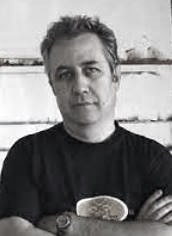M.A. Charris
Ángel Mateo Charris, 1962, Cartagena (Spain).
He entered the Faculty of Fine Arts of San Carlos de Valencia in 1980.
Next to the comic -Hergé appears among his most immediate influences-, he initially incorporates the plastic ways of Pop, although from very early on he adopts an open and receptive attitude towards the diversity of fonts and stylistic options offered by the history of art. At the end of his degree, he complements his training with graphic design studies, whose compositional methods will have a decisive influence on his work.
In 1988, on the occasion of his first stay in New York, and in the company of fellow painter Gonzalo Sicre, he delved into American painting, especially the work of Edward Hopper and the nineteenth-century tradition of the representatives of the Hudson River School.
At the beginning of the 90s he definitely opted for a fully figurative pictorial practice, in which the use of visual citations that refer to cinema, art history or advertising, with a subtle conceptual rhetoric.
In the footsteps of Hopper, a book published in 1997 together with Gonzalo Sicre, the result of his third stay in the United States- and a calculated exoticism -desert, frozen landscapes-, constituting critical scenarios in which he honors or questions the directions of the art of the century. XX.
The complex iconography of his tributes and appointments includes artists who have been particularly important in his training such as Klee, Miró, Hopper, Friedrich, De Chirico, Torres-García, Van Gogh, Sorolla, Beuys, Dalí, Renau, incorporating each canvas fragments of the artist to whom he dedicates the tribute that are juxtaposed with images taken from the media.
In 2001 he is commissioned by the La Mar de Músicas festival to make an exhibition about a trip to Mali, which results in the exhibition and the book Tubabus en Tongorongo. From this and other trips (Burma, Japan, Kenya, Mexico, Europe) he extracts the other main source with which he constructs his poetics, which has been described by art critics as a “disturbing universe that mixes the style of Miró, Dalí , Chagal or De Chirico. ”His individual exhibitions take place in different Spanish cities–Murcia, Añlicante, Madrid, Barcelona, Valencia, Cádiz, Orense, San Sebastan, Zaragoza, Pamplona or Santander-, although he participates in international groups such.

